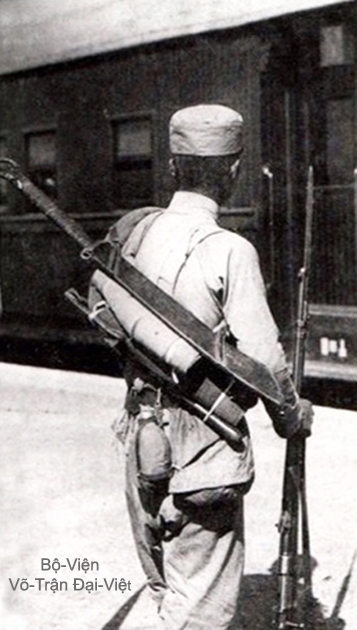II.
THE MEDIEVAL WEAPONS
2 - The Edged-Arms
THE SCIMITAR
« Đại Đao »
大刀
In nowadays, it still always exists many martial students who make the confusion between the Sabre « Đao » and the Scimitar « Mã-Tấu ».
- The « Sabre - Đao » is a kind of single edge Sword with a relatively narow and curved Blade, belonging to the category of « Sabre Beared on one's Side - Yêu-Ðao » (腰 刀) and it's wielded with one hand.
- When the « Sabre - Đao » owns a large Blade, it's called Great-Sabre Ðại-Ðao (大 刀). Currently, it still exist Vietnameses who make th error to call the « Siêu-Ðao » (超 刀) by Ðại-Ðao (大 刀) according to the way whom various chinese Martial Arts School have the habit to do it.
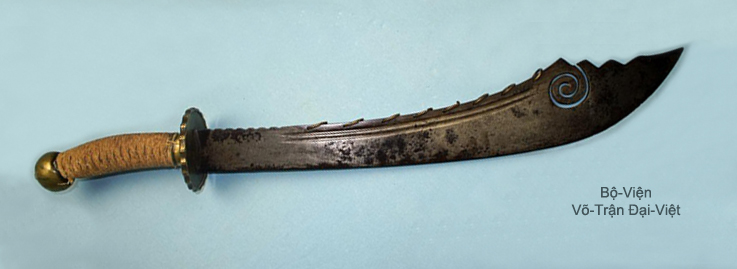
One-Handed Great Sabre « Đại-Đao 大 刀 » with Single Steel Edge
from a Tai-Ping Rebellion's Warrior
in the Empress Dowager Tseu-Hi 慈 禧 (1861~1908) period.
CHINA - Circa 1900.
(Brought back from China by UK Brigadier General G.H. Turner)
(Photo Credit : Gavin Nugent, swordsantiqueweapons.com)
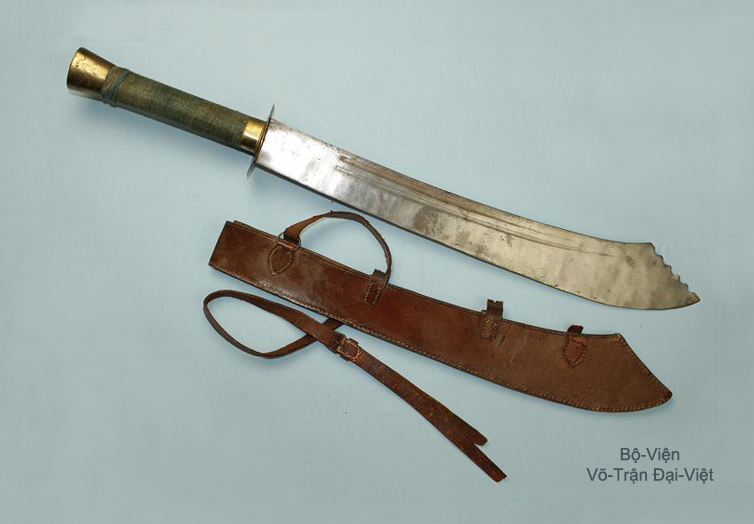
One-Handed Great Sabre « Đại-Đao 大 刀 » with indented apical part,
designed according to a particular model of « Evil-Headed Scimitar - Quỷ-Đầu Đao (鬼 頭 刀) »
(used during the Republican Warlord Era Jūnfá shídài 軍 閥 時 代 (1916–1928) in China).
(Photo Credit :Gavin Nugent, swordsantiqueweapons.com)
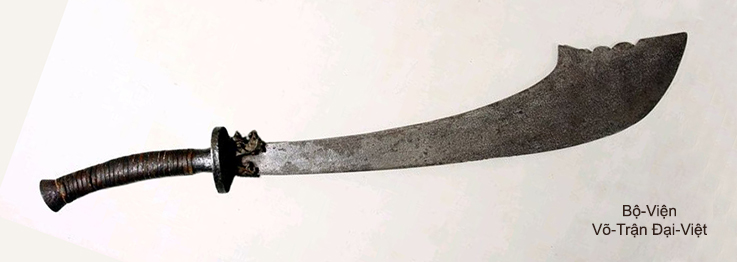
One-Handed Great Sabre « Đại-Đao 大 刀 » with stylized cloud flaked apical part,
so it is named « Cloudheaded Scimitar - Vân-Thủ Đao 雲 頭 刀 »
designed according to a particular model of « Evil-Headed Scimitar - Quỷ-Đầu Đao (鬼 頭 刀) ».
(Photo Credit :Gavin Nugent, swordsantiqueweapons.com)
- The « Scimitar - Mã-Tấu » belongs to the category of « Long Sabres - Trường-Đao » (長 刀), having a Blade still more large and a weight more important than the one of the Sabres « Đao » and it is wielded with Two Hands, sometimes with One-Hand.. It's held of a long handle from 40 cm to about 80 cm.
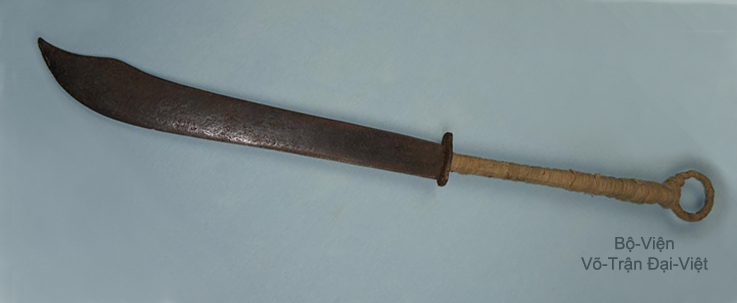
Long Sabre - Trường-Đao (長 刀) Two-Handed « Scimitar - Mã-Tấu »
with a Blade looking like the one from Đại-Việt One-Handed Scimitar.
(Photo Credit :Gavin Nugent, swordsantiqueweapons.com)
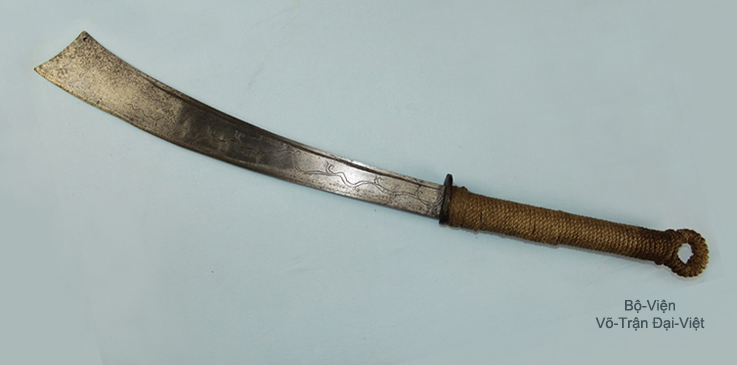
Long Sabre - Trường-Đao (長 刀) Two-Handed « Scimitar - Mã-Tấu »,
with specific décorations from Đại-Việt engraved on the blade.
(Photo Credit :Gavin Nugent, swordsantiqueweapons.com)
However, this category of « Scimitar - Mã-Tấu » is often called « Great Sabre - Ðại-Ðao 大 刀 » in Centre-Việt-Nam.
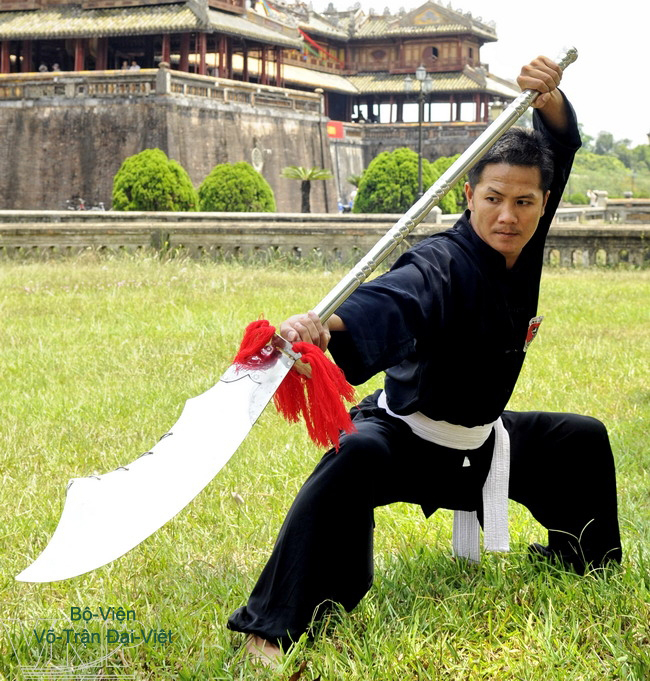
« Scimitar - Mã-Tấu » often called « Great Sabre - Đại-Đao 大 刀 » in Center-Việt-Nam.
( On the Photo the « Great-Sabre - Đại-Đao » is holding a « Spear Boble », that is not compatible )
(Photo Credit : Bạch-Hổ Martial Arts School)
There's a kind of edged arm taking form from « Tiger-Headed Sabre - Hổ-Đầu Đao » (虎 頭 刀) or «Tiger-Toothed Sabre - Hổ-Nha Đao » ( 虎 牙 刀 ).In bygone days, Chineses used this kind of Sabre Ðao with large Blade for fighting on horseback, hence the name of « Equestrian Sabre - Mã-Đao » (馬 刀), and Vietnameses had pronounced phonetically « Mã-Tấu » ; later, the Scimitar « Mã-Tấu » was used also on foot fighting and was still called « Sabre for Severing Horses - Trảm-Mã Đao » (斬 馬 刀).

Cavalry using « Tiger-Head Sabre - Hổ-Đầu Đao » (虎 頭 刀)
still called « Tiger-Fang Sabre - Hổ-Nha Đao » (虎 牙刀).
MINH (MING - 1368 - 1644) Dynasty
(Photo Credit : Thomas CHEN )
The« Scimitar Beared on one's Back - Bối-Ðao » (背 刀), « Evil- Headed Scimitar - Quỷ-Ðầu-Ðao » (鬼 頭 刀), « Scimitar with Rings - Hoàn-Đao » (環 刀), etc. from China, belong to the category of Scimitars « Mã-Tấu ».
The Scimitars « Mã-Tấu » are wielded with one hand or two hands, while the Sabre « Đao » is wielded only with one hand.
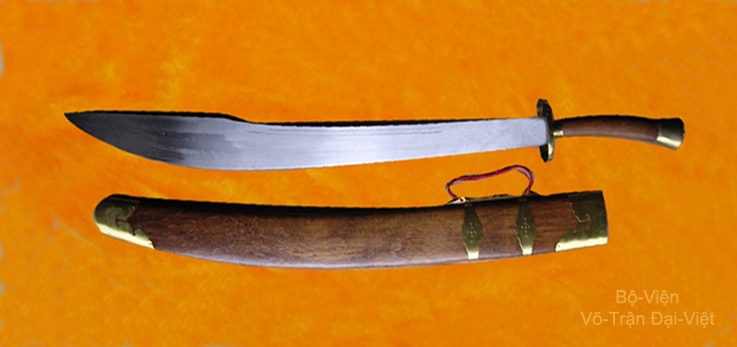
One-Handed Great Sabre « Đại-Đao 大 刀 »,
considered as Scimitar « Mã-Tấu » (馬 刀) in Việt-Nam.
(China - Re-Enactment for Training in Martial Arts Drill Halls)
(Photo Credit : Wing-Lam Enterprises)
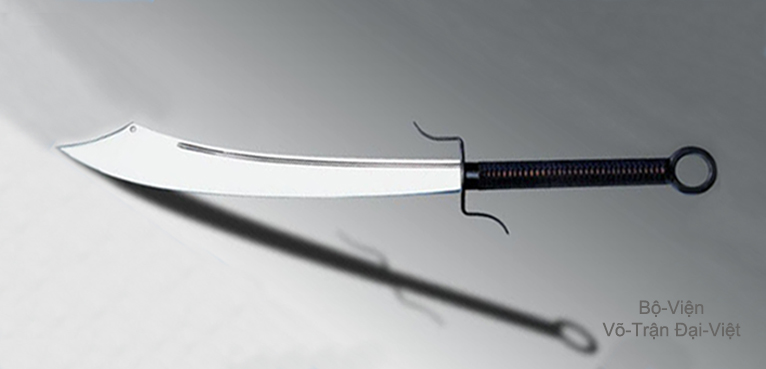
Two-Handed « Sabre for Severing Horses - Trảm Mã-Đao 斬馬刀 » in steel, with Single Edge.
(Credit Photo : Cold Steel)
Chinese Scimitar « Mã-Tấu » (馬 刀) used in World War II. (Credit Photo : Thomas Chen) |
Chinese Scimitar « Mã-Tấu » (馬 刀) from China, (Credit Photo : Thomas Chen) |
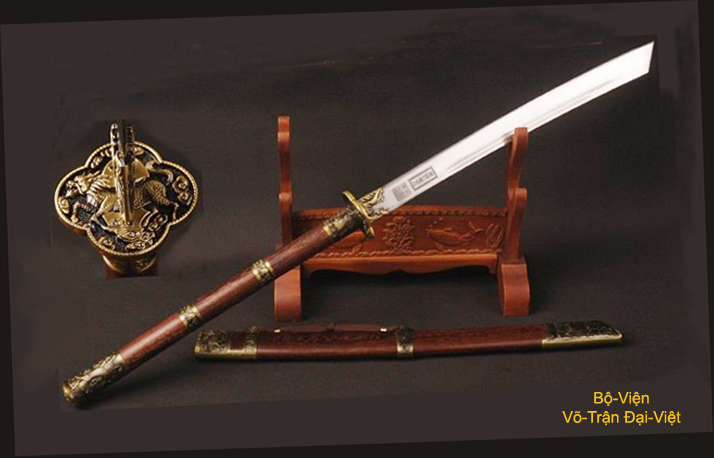
Historic Re-Enactment of Two-Handed Scimitar
« Severing Horses Scimitar - Trảm Mã-Đao 斬馬刀 »
from Emperor Khang-Hi ( Kangxi 1654-1722) of QING Dynasty.
(To be continued...)
Committee of TRỊNH Quang Thắng |
Copyright © 2004 - 2018 by ACFDV - All rights reserved.
